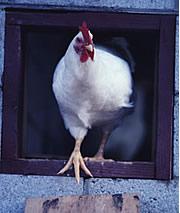 Bird flu deaths in Turkey confirm the expectation that human cases may always follow poultry outbreaks.© Getty
Bird flu deaths in Turkey confirm the expectation that human cases may always follow poultry outbreaks.© GettyTwo deaths from avian flu have been reported in Turkey. If confirmed, the cases would be the first outside Asia, where the H5N1 virus has already infected more than 140 people, killing 74 of them.
Confusion has reigned since the death of the first patient in Turkey, a 14-year old boy from Do&gcaron;ubeyazit, a town in the east of the country on the border with Iran. On 2 January, the Turkish health ministry stated that the boy and his 15-year old sister, who died today, did not have avian flu.
But on 4 January it reversed its position, stating that tests had identified the virus as H5N1 in both children, and in another sick member of the family. Samples have been sent to the World Health Organization for confirmatory testing. As many as a dozen other suspect cases are under surveillance.
Albert Osterhaus, a virologist at the Erasmus Medical Centre in Rotterdam in the Netherlands, says that the occurrence of human cases on the frontiers of Europe highlights the need for rapid action to detect and eliminate outbreaks in animals. It also confirms the "worrisome" expectation that human cases of avian flu may occur wherever there are poultry outbreaks, he adds.
Avian flu first arrived in Europe's birds last July, when avian outbreaks occurred in Russia. It has since appeared in Kazakhstan, Croatia, Romania and Turkey.
In your own backyard
Farming conditions in Turkey, where backyard farms are common, are more similar to Asian countries than many European countries. Europe mostly has industrial poultry operations that can be cut off from everyday contact with people. But that doesn't mean countries should be complacent, Osterhaus says.
Osterhaus was involved in controlling an outbreak of the H7N7 avian flu in the Netherlands in 2003, where 30 million chickens in industrial operations were culled. The outbreak affected relatively large numbers of people, he points out: 88 farm workers and family members were infected, and one veterinarian died.
Although industrial farming involves less contact between people and poultry, outbreaks in high-density farms can create ideal conditions for amplification of the virus, notes Osterhaus.
ADVERTISEMENT
The lesson learned in the Netherlands, he says, was that immediate control measures, with tough enforcement, are needed as soon as an outbreak is detected.
But Turkey, Russia, and Croatia, have yet to stop the spread of poultry outbreaks, so the risk of more human infections is very real, says Osterhaus.
However, he adds that the new cases in Europe "do not fundamentally increase the pandemic potential of the virus", compared with the situation in Asia. "With 142 cases in Asia, a couple of new ones on the doorstep of Europe doesn't change much," he says.
